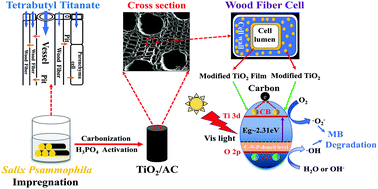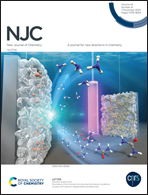Synthesizing C–N–P-tridoped TiO2 in a Salix psammophila-activated carbon body to enhance its regeneration performance
Abstract
Based on the natural interconnected pore networks of Salix psammophila (SP), TiO2 was synthesized in an SP-based activated carbon (AC) body through a series of facile processes including impregnation, calcination, and activation. Compared with the traditional surface modification, TiO2/AC (TiO2 and AC composite) in this study exhibited better durability and higher regeneration performance under visible-light irradiation. There were five reasons: (1) the binding force between TiO2 and AC was significantly enhanced, and methylene blue removal ratio only decreased by 11% after three trials; (2) C, N, and P atoms were spontaneously incorporated into the TiO2 lattice during the synthesis processes, which observably extended the TiO2's visible-light response; (3) the anatase/rutile mixed phase and greater surface hydroxyl concentration elevated TiO2 photodegradation; (4) AC being close to TiO2 was able to trap electrons, further increasing the TiO2's photocatalytic activity; (5) the synergistic effect of adsorption and photodegradation was enhanced. With increasing TiO2 content, TiO2/AC regeneration performance was improved initially and then became weak; TiO2/AC2 : 1 (2 : 1 is the mass ratio of tetrabutyl titanate and ethanol) exhibited the highest regeneration performance: 55% methylene blue was removed by the saturated AC after 2 h visible-light irradiation, which was almost double that of the traditional surface-modified sample.



 Please wait while we load your content...
Please wait while we load your content...